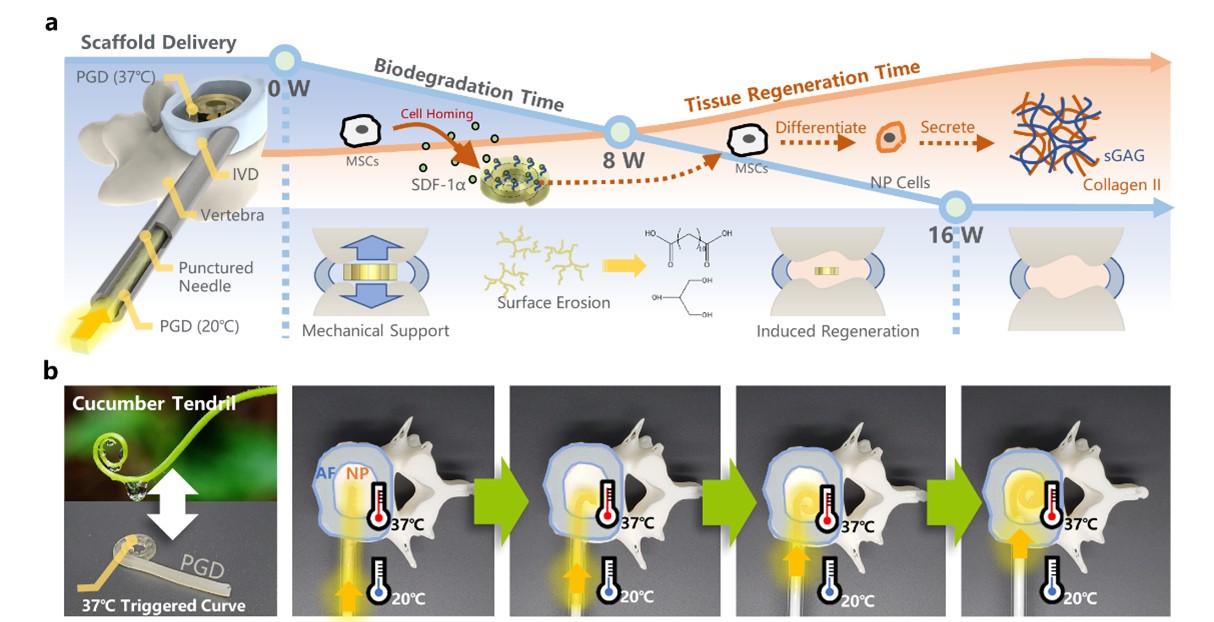Recently, the team of Professor Fan Yubo and Professor Wang Lizhen from the Key Laboratory for Biomechanics and Mechanobiology of Ministry of Education and Beijing Advanced Innovation Center for Biomedical Engineering, Beihang University, reported a new minimally invasive implantable biodegradable nucleus pulposus (NP) scaffold (Fig. 1). It is found that the temperature-sensitive shape memory polymer poly(glycerol-dodecanoate) (PGD) NP scaffold, whose mechanical property is controlled to the similar with human NP by adjusting synthetic parameters, can maintain the disc height, also recruit autologous stem cells, and regenerate degenerated NP.

Fig.1 Schematic of the new minimally invasive implantable biodegradable NP scaffold
The research team first tailored the shape memory and mechanical properties of PGD (Fig.2). Combined with experimental and numerical simulation techniques, a set of PGD synthesis parameters (MRH/C=1.50, t=72h) closest to the compressive modulus of native NP (1.01±0.43MPa) was finally selected and verified to fabricate the NP scaffold. The design of a minimally invasive NP scaffold with regeneration inspired by a tendril of cucumber vine. With the help of the New Zealand rabbit lumbar disc degeneration model, the functional repair of the NP of the PGD scaffold was verified from the aspects of clinical indications, cell composition, and postoperative mechanical properties of the intervertebral disc. The results showed that the PGD NP scaffold could provide effective mechanical support immediately after implantation and maintain about 80% of the normal intervertebral height (Fig.3). The stromal cell-derived factors contained in the scaffold effectively recruited autologous stem cells into the degenerative NP ( Fig.4 ). At 16 weeks after implantation, the scaffold can maintain the initial intervertebral height and the mechanical properties were close to the normal intervertebral disc (Fig.5). The design of a minimally invasive NP scaffold with regeneration will be an innovative idea for treatment of disc degeneration, which also has potential application in clinic.

Fig. 2 Shape memory and mechanical properties of PGD by adjusting synthesis parameters to meet the needs of implantation.

Fig.3 Variation of disc height and T2 MRI signal intensity of NP during the 16 weeks implantation, and mechanical properties of the discs at 16 weeks.

Fig.4 Tissue morphology and cell composition in NP scaffold and hyaluronic acid scaffold group, sham operation group and normal group after the implantation of rabbit lumbar disc.

Fig.5 Comparison of mechanical properties between PGD NP scaffold and hyaluronic acid scaffold group, sham operation group and normal group after 16 weeks of implantation of rabbit lumbar disc.
The study titled "Innovative design of minimal invasive biodegradable poly(glycerol-dodecanoate) nucleus pulposus scaffold with function regeneration" was published in the famous comprehensive journal Nature Communications. Professor Fan Yubo from Beihang University is the corresponding author, and Professor Wang Lizhen and her doctoral student Jin Kaixiang from Beihang University are the co-first authors of this paper.
Link to the Article:https://www.nature.com/articles/s41467-023-39604-0
Reported by Ni Yikun
Reviewed by Li Deyu
Edited by Jia Aiping
Translated by Yao Zipeng

